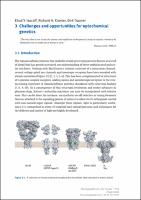Chapter 3 Challenges and opportunities for optochemical genetics
Author(s)
Isacoff, Ehud Y.
Kramer, Richard H.
Trauner, Dirk
Contributor(s)
Hegemann, Peter (editor)
Sigrist, Stephan (editor)
Collection
European Research Council (ERC)Language
EnglishAbstract
The transmembrane proteins that underlie neural processing are now known at a level of detail that has greatly increased our understanding of these sophisticated molecular machines. Starting with MacKinnon’s seminal structure of a potassium channel, several voltage-gated ion channels and ionotropic receptors have been revealed with atomic resolution (Figure 3.1) [2, 3, 4, 5, 6]. This has been complemented by structures of G-protein coupled receptors, adding opsins and metabotropic receptors to the ever-increasing repertoire of transmembrane proteins elucidated with structural biology [7, 8, 9, 10]. As a consequence of this structural revolution and recent advances in pharmacology, Nature’s molecular machines can now be manipulated with relative ease. This can be done, for instance, via synthetic on-off switches or tuning elements that are attached to the signaling protein of interest to allow for its orthogonal control with non-natural input signals. Amongst these signals, light is particularly useful, since it is unmatched in terms of temporal and spatial precision and techniques for the delivery and control of light are highly developed.
Book
OptogeneticsKeywords
Biophysics; Genetic Engineering; Neuroscience; Optics; Vision RestorationDOI
10.1515/9783110270723.35ISBN
9783110270716OCN
1135847271Publisher
De GruyterPublisher website
https://www.degruyter.com/Publication date and place
Berlin/Boston, 2013Grantor
Classification
Biophysics
Genetics (non-medical)
Neurosciences
Human biology


 Download
Download